It’s not profound to note that communities develop around water, as a requisite of human life and a source of livelihood.
Appropriately, we’ve spent a lot of our trip to SE Asia on the water, including four excursions on the Mekong river, kayaking and sleeping amid limestone islands on Ha Long Bay, rafting in the hill country of Thailand, and scuba-diving/snorkeling on the Gulf of Thailand and Andaman Sea.

But the 150,000 villagers who live on and around Inle Lake, Myanmar, are never far from water. Their villages perch on bamboo stilts hammered into the lake bed, since the water rises regularly in the wet season to lap at the floor boards. It’s a bit like the bayous of the Gulf Coast, but with whole towns rather than isolated buildings perching above the water. The meeting places and schools are no different. Children spill out of their schools onto bamboo platforms and paddle themselves off or wait for their parents to moor alongside.
The streets are just the parts of the lake between rows of houses. Even more so than Venice, to get anywhere you need a boat, typically tethered below the house. The wealthier have flat-bottom long boats powered by a raucous diesel motor; the poorer apply oars in theirs. The young and the old both must paddle about to get anywhere.
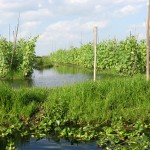
Water is the essence of their life in many ways here. A principal source of livelihood is vegetable farming, all of which is done on the surface of the lake itself. To create these floating gardens, mud is gathered from the lake bottom and then floated on the surface, pinned in place and in cultivated rows by driven bamboo stilts. On the floating mud rows, separated by the lake water, grow tomatoes, cucumbers, onions, gourds and various greens. We hiked up the mountains ringing the lake to gain perspective on these fields.
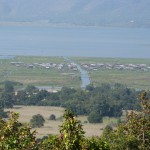
One village’s “floating” fields extended over a half mile along the lake shore, and perhaps a third of a mile across. We finally figured out that huge portions of the lake that we first took to be land actually were floating fields.
It’s somewhat disconcerting for a visitor not to know whether you are on shore or water. We biked along a levee that began on land and reached into more and more ambiguous terrain as we got deeper into one of the villages. At first, on either side, we passed wood and bamboo homes on stilts, accessible across an irrigation canal by a short plank bridge. On the far side of the houses, though, it was water again as rice paddies sprawled to the apparent edge of the lake and imperceptibly yielded to the growing plants and houses standing in lake water itself.
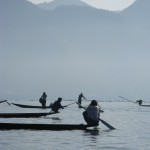
Not surprisingly, however, a second livelihood for villagers is fishing. Here, they’ve adapted their techniques to the frequent shallowness and clarity of the water. As you tour the lake, a few men slap the surface with poles to drive the skittish fish into nets held taut by others.
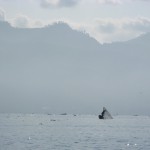
Some fishermen work individually with a conical basket made of netting. They paddle slowly and search for fish, then quickly lower the basket onto the lake floor over their prey. Then, using a bamboo stick in the center of the basket, they prod the captive fish into the grasp of the net, so they can raise the basket with the caught fish. Yes, we had to see a demonstration of this to fully get it.

In order to free their hands for these methods, the Inle Lake villagers have evolved an unusual rowing technique. They brace one leg on the inside of the prow of their long boat, wrap the other leg around a long oar and push that oar with the unanchored leg through the water to move forward.
So, here amid the most watery of communities, it’s not surprising that the people meet their religious needs within the water.

One of the holiest sites in Myanmar, in fact, is the Phaung Daw Oo Buddhist pagoda that rises high upon platforms and stilts in the center of the lake, accessible only by boat. Its sacredness is assured by the presence of five gold Buddha statues cast a thousand years ago. As is the custom with revered statues like these, pilgrims come to honor Buddha and pray for some help by applying a small square of gold leaf to the statue.
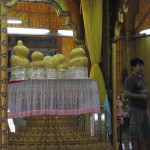
Just 70 years ago you could still see their shape and some detail of the figure despite the gradual application of leaves by visitors. Now, with easier access to the lake and increasing interest around the world, the Buddhas have been covered with so much gold leaf that they look like bubbled blobs.
And, as is usually the case with holy sites, there is a miraculous legend that enhances the sacredness, this one just under 50 years old plus water-related. During the festival time in January, the Buddha statues are removed from the pagoda, placed on a royal barge, and then propelled around the lake by village oarsmen. In 1965, the barge sank in a sudden storm. Four of the statues were recovered immediately, but the fifth somehow navigated back to the pagoda on its own. In recognition of the statue’s unwillingness to boat about, that one has been left back at the pagoda in festivals since.
That gold-encrusted Buddha might have the option of staying off the water. But all the villagers here must live by gliding or abiding on waterways.
(To see more pictures from Myanmar, CLICK HERE to view the slideshow at the end of the Myanmar itinerary page.)


Great pics!